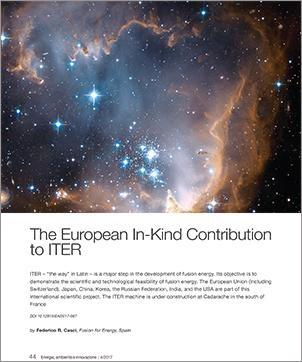
The European In-Kind Contribution to ITER
by Federico R. Casci, Fusion for Energy, Spain
DOI 10.12910/EAI2017-067
ITER – “the way” in Latin – is a major step in the development of fusion energy. Its objective is to demonstrate the scientific and technological feasibility of fusion energy. The European Union (including Switzerland), Japan, China, Korea, the Russian Federation, India, and the USA are part of this international scientific project. The ITER machine is under construction at Cadarache in the south of France
Fusion is the process that powers the sun and other stars and makes life on Earth possible. It consists in fusing together light atoms (i.e. Deuterium and Tritium – isotopes of Hydrogen) to make heavier ones (i.e. Helium). On earth it is not possible to replicate the extreme pressure within the sun. Consequently, to allow fusion to happen much higher temperatures are necessary, over 100 million degrees. During fusion reactions a small amount of mass is converted into energy, in accordance with Einstein’s well-known equation.
The attractiveness of fusion is due to its many advantages. The basic fuels (deuterium and lithium, the latter used to breed tritium) are abundant, it generates no greenhouse gas emissions and has a low impact on the environment with no long-lasting radioactive waste. Fusion reactors are also inherent safe because meltdown or runaway reactions are impossible.
ITER uses magnetic confinement through very high magnetic fields to give the plasma a toroidal shape inside the machine vessel and to contain it long enough and away from the walls of the container to allow fusion to occur.
The current ITER schedule foresees first plasma at the end of 2025 and the start of full Deuterium-Tritium operations in 2035. …

